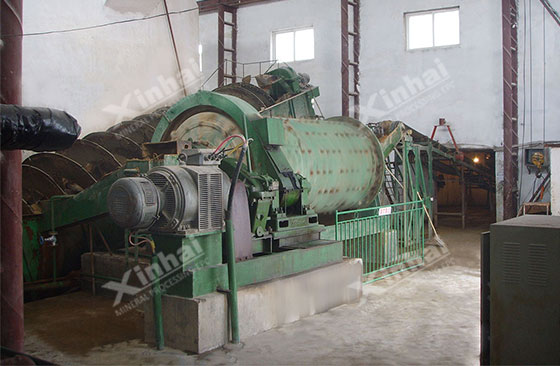
Kaolin mineral is a common clay mineral in the natural world. It is a useful mineral for white pigment, therefore, whiteness is an important index influencing the value of kaolin mineral. There are iron, organic matter, dark material and other impurities in kaolin mineral. These impurities will make kaolin mineral appearing in different colors, influencing the whiteness. So kaolin mineral must remove the impurities.
The common purification methods of kaolin mineral include gravity separation, magnetic separation, flotation, chemical treatment, etc. The following are the common purification methods of kaolin mineral:
The gravity separation method mainly USES the density difference between gangue mineral and kaolin mineral to remove the high-density impurities of light organic matter, quartz, feldspar and elements containing iron, titanium and manganese, so as to reduce the influence of impurities on the whiteness. Centrifugal concentrators are usually used to remove high-density impurities. The hydrocyclone group can also be used to finish the washing and screening of kaolin mineral in the process of sorting, which can not only achieve the purpose of washing and grading, but also remove some impurities, which has a good application value.

However, it is difficult to obtain qualified kaolin mineral products by reseparation method, and the final qualified products must be obtained by magnetic separation, flotation, calcination and other methods.
Almost all kaolin minerals contain a small amount of iron ore, generally 0.5-3%, mainly magnetite, ilmenite, siderite, pyrite and other coloring impurities. Magnetic separation mainly USES the magnetic difference between gangue mineral and kaolin mineral to remove these colored impurities.

For magnetite, ilmenite and other strong magnetic minerals or iron filings mixed in the processing process, using the magnetic separation method to separate kaolin mineral is more effective. For weak magnetic minerals, there are two main methods: one is to roast, make it become a strong magnetic iron oxide mineral, then carry on the magnetic separation; Another way is to use a high gradient magnetic field magnetic separation method for magnetic separation. Because magnetic separation does not require the use of chemical agents, the environment will not cause pollution, so in the process of non - metallic mineral processing is more widely used. The magnetic separation method has effectively solved the problem of the exploitation and utilization of the low-grade kaolin mineral which is not of commercial mining value due to the high content of iron ore.
However, it is difficult to obtain high-grade kaolin products by magnetic separation alone, and chemical treatment and other processes are needed to further reduce the content of iron in kaolin products.
The flotation method mainly uses the physical and chemical differences between gangue minerals and kaolin mineral to treat the raw kaolin mineral with more impurities and lower whiteness, and remove the impurities containing iron, titanium and carbon, so as to realize the comprehensive utilization of low-grade kaolin mineral resources.

Kaolin mineral is a typical clay mineral. Impurities such as iron and titanium are often embedded in kaolin particles, so the raw ore must be ground to a certain degree of fineness. Kaolinite commonly used flotation method for ultra-fine particle flotation method, double fluid layer flotation method and selective flocculation flotation method, etc.
Flotation can effectively increase the whiteness of kaolin, while the disadvantage is that it needs chemical reagents and costs a lot, easily to cause pollution.
Chemical leaching: some impurities in kaolin mineral can be selectively dissolved by sulfuric acid, hydrochloric acid, nitric acid and other leaching agents to remove impurities. This method can be used to remove hematite, limonite and siderite from low grade kaolin mineral.
Chemical bleaching: the impurities in kaolin mineral can be oxidized into soluble substances through bleaching, which can be washed and removed to improve the whiteness of kaolin products. However, chemical bleaching is relatively expensive and is usually used in kaolin concentrate, which needs further purification after decontamination.
Roasting purification: the difference in chemical composition and reactivity between impurities and kaolin mineral can be used for magnetization roasting, high-temperature roasting or chlorination roasting to remove impurities such as iron, carbon and sulfide in kaolin mineral. This method can improve the chemical reactivity of calcined products, greatly improve the whiteness of kaolin, and obtain high-grade kaolin products. But the disadvantage of roasting purification is that the energy consumption is large, easy to cause environmental pollution.

It is hard to get high-grade kaolin concentrates through a single technology. Therefore, in actual production, we suggest you to choose a qualified mineral processing equipment manufacturer. Carrying out mineral processing experiment and applying multiple processing technologies to increase the quality of Kaolin mineral.
1.Vietnam 800tpd graphite processing project

2.Uganda 720tpd phosphate processing project

3.Hunan 700tpd feldspar processing project

4.Inner Mongolia 700tpd fluorite processing project

5.Hebei 400tpd feldspar processing project

To find out more about our products and solutions, please fill out the form below and one of our experts will get back to you shortly.